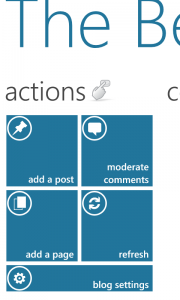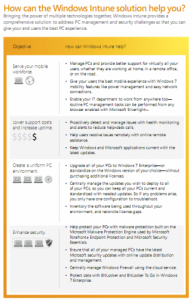 Last month, Microsoft finally unveiled its new cloud-based enterprise productivity and communications suite, Office 365. With more and more small and mid-sized businesses embracing the cloud-based potential of Google Apps, it’s not particularly surprising that Ballmer & the boys decided to fire their own volley. What is surprising, though, is just how robust, well-executed, and affordable the new Office 365 manages to be; for small businesses feeling encumbered by their current software systems, Office 365 might be the solution. Read More
Last month, Microsoft finally unveiled its new cloud-based enterprise productivity and communications suite, Office 365. With more and more small and mid-sized businesses embracing the cloud-based potential of Google Apps, it’s not particularly surprising that Ballmer & the boys decided to fire their own volley. What is surprising, though, is just how robust, well-executed, and affordable the new Office 365 manages to be; for small businesses feeling encumbered by their current software systems, Office 365 might be the solution. Read More
Tag: microsoft
Why Skype is not quite ready for the Enterprise
 As I’m sure you’re aware, the folks over at Microsoft have gambled big recently by purchasing Skype. Microsoft has long been regarded as the first name in enterprise software, but does Skype fit in with the rest of the class of Microsoft products? Or, are they the weird kid that eats paste? To be blunt: for now, hide your paste.
As I’m sure you’re aware, the folks over at Microsoft have gambled big recently by purchasing Skype. Microsoft has long been regarded as the first name in enterprise software, but does Skype fit in with the rest of the class of Microsoft products? Or, are they the weird kid that eats paste? To be blunt: for now, hide your paste.
About a year ago my office converted to all-Skype. The company phones are Skype phones, and most of us now just have a mic and our headphones rather than a desk handset. Although this is a great product for people in long distance relationships, or those who want to see their grandchildren in another state, this product needs a few improvements before we can really rely on it for serious business.
As you probably know, they had a global outage this week so stability is a big concern. However, lots of services have had major outages recently and survived unscathed. The biggest issue for the business so far is that many folks already had a Skype account when they joined the company, and they’re unable to merge their personal account with the new company-funded account. This means they had to move all of their contacts over to a new Skype screen name, and it’s often extremely confusing to newcomers who arrive with many clients (like salesmen, who live and die by their phone). After the transition to the company-based Skype, some employees seem to be even more nervous about missing that big call.
Another issue – with Skype, there’s no central phone directory for your company. The closest that we’ve been able to come is to include our company name in all the usernames that we create. This way, folks can search for our names and find our people. This isn’t a great solution, though, as there’s no security provided. Nothing bars other users from using your company’s name in their usernames, potentially causing “false positives”- imagine if a competitor caught on and convinced a customer to call them, because the customer thought the competitor was affiliated with your company? A directory is a near-mandatory staple for enterprise telecommunication solution.
Payment is also a problem. When you have lots of people making tons of calls all around the country, it’s common to add large amounts of credit to your account to cover costs. With a terrestrial phone service it’s common to add thousands of dollars at a time to your corporate phone account. With Skype, if you want to add 500 or more dollars to your account you have to fax in a special form. This seems pretty stone-age for a digital-frontier company. And, if you need to fax in several forms, you’re occasionally flagged, causing service interruptions! In a digital age, with a digital business, it’s a total waste of time to constantly fill out and fax forms, even when you have sites like eFax to help.
As a web-based phone service, Skype really should excel at inexpensive teleconferencing. Although it’s touted as the ‘facetime killer” Skype actually has very little support for true video or teleconference support. When we have a large meeting with several remote people, we’re usually unable to configure it so that we can all see and hear each other without a lot of microphone-passing and hand-waving. Consequently, people in remote offices often feel left out of the loop.
Last but certainly not least is the fact that all of their equipment is proprietary. With terrestrial phones, there is usually an equipment standard so that generally your handset can go with you from service provider to service provider. Not Skype phones. Skype phones require commitment. So, now that we have invested in this equipment, we feel somewhat stuck with it, since we can’t re-use the handsets. We’re what a poker player would call ‘pot committed’.
Even with all this (I know that it’s hard to tell,) I actually love Skype—I really do! I’ve had great fun with it, and it’s perfect for chatting with your family or your significant other when they’re out of town. To really meet the needs of the business community, however, Skype should definitely take some cues from their new owners and start thinking about providing service from an enterprise perspective.
Handyscan Document Scanner for Windows Phone 7
Smartphone cameras come pretty much standard with uber-high megapixel cameras nowadays – Prolly more than your average consumer will ever need. Simply because most of us still have a trusty-old (or new) point-and-shoot camera for “real pictures”. So I can’t think of any other purpose to use the smartphone camera for than using it as a document scanner for those documents that you need to send to a friend, family member, or client when your phone is the only piece of technology you have on your person at that moment.
Developers JDB Pocketware wasted no time in creating the Handyscan app for Microsoft Windows Phone 7 devices that snaps a shot of the image and can convert it to either .jpg or .pdf to quickly send to anyone.
Handyscan can emulate the functions of an actual document/image scanner by scanning multiple documents and creating one file and edit options like the ability to align/rotate, crop and change the size/resolution of scanned documents. Additionally, Handyscan has also a ‘typewriter’ feature which allows you to type text into scanned documents or forms.
Handyscan for WP7 devices can be downloaded from the Windows Phone Marketplace on your device for $2.99. There is also a free lite version that excludes the options of choosing the file format (.jpg or .pdf) and size/resolution of scanned documents.
Of Course, even if you have the best lighting and a super-steady hand, a scanned document using an actual scanner will produce the best document quality, but I don’t know anyone who carries one of those around with them…just in case. So for those times when you need to get that document scanned and sent sooner the later, why not rely on your smartphone?
…You already rely on it for everything else
Official WordPress app for Windows Phone 7
 Any brave bloggers out there grab the first iteration of the Windows Phone? If so, WordPress has released an official app for WP7 devices that from the images, looks pretty sweet.
Any brave bloggers out there grab the first iteration of the Windows Phone? If so, WordPress has released an official app for WP7 devices that from the images, looks pretty sweet.
Looks aside, WordPress for WP7 doesn’t bring anything extraordinary to the table outside of now being available to WP7 users. So heavy mobile bloggers should be able to add their blog and navigate the new app with no troubles. But just in case there are some newbies to mobile blogging with WordPress, here is just a short list of the options available for mobile users:
– Create/edit posts and pages
– Manage multiple blogs
– Add Media to library
– Moderate comments
– View stats
Whether you’re blogging as a personal hobby, to get more exposure for your business, or blog as a business, you want access to your WordPress site while your on the go just in case you’re inspired to post a pic, video, or quick story to your site as soon as the moment presents itself. With the WordPress app now available for WP7 devices, the Microsoft faithful can join the “Big Three” (Apple, Android & BlackBerry) users who can share and exchange valuable information with WordPress blog subscribers…whenever and wherever.
Microsoft’s Intune – a new tool for businesses to manage their PCs
Microsoft has launched a new beta for its new product for businesses that is in Beta. Intune is a PC management and security tool for Windows offices which provides a console for you to manage security updates, anti-virus, upgrades and physical inventory. The beta is designed for enterprises with 5 to 25 PCs and is limited to the first 10,000 signups.
It is another step into the cloud by Microsoft. And a project we will follow with interest.
Skywriting? Try Google docs and Microsoft Office’s Web Apps for Cloud Collaboration
When we talk about working in The Cloud, what do we mean? Web-based software applications are the fastest-expanding Cloud technologies.
The first of these applications to gain a significant share of users was Google Docs with a four-year head start. Google has documents, spreadsheets, presentations, drawings and forms. You can create, share, and collaborate on any of these tasks with co-workers, friends or members of your organizations. You can control if you want your work to be public or just shared with designated individuals. And it is all free. Want to give it a try but need an idea for a project? How about trying a family calendar? Google Docs has lots of templates that users have uploaded and rated.
Just this past week, Microsoft joined the Cloud-based Aps world with its new Office 2010 Web Apps beta. The idea of the dominant business technology provider giving free access to their software was unimaginable up to now, but here we go with easy-to-use, easy-to-share and easy-to-access software that will be recognizable to anyone using Microsoft products in their work life.
The website Lifehacker gives a program by program comparison. Try them out—life in the Cloud is getting interesting.
New Microsoft Office 2010 goes mobile for FREE!
Microsoft goes mobile with Office 2010! Will it give you the productivity you need while on-the-go? This week Microsoft has finalized their release of the new Office 2010. While most reviews are covering the differences of the previous desktop version (here’s Walt Mossberg’s look at Office 2010) many are overlooking the availability to have Office 2010 on your mobile device.

In todays hyper-competitive, real-time environment your “office” must be wherever you are located! If you want to realize growth in your business you have to embrace being mobile & not the typical 20% phone feature usage – the 80% growth in mobile is identifying the right apps that will make you more productive. In my presentations I often say “In business a smartphone is only as good as the apps you run on it” otherwise it may as well be a doorstop! Don’t underestimate the mobile growth, in 2013 there will be close to 900 million worldwide mobile internet users (according to IDC, Worldwide Digital Marketplace Model and Forecast, December 2009)
This brings me back to Microsoft Office 2010! In my opinion, Microsoft has made a very smart move in offering the mobile version FREE with any Windows Mobile phones that has version 6.5 or above! Office 2010 for mobile includes Word Mobile 2010, Excel Mobile 2010, PowerPoint Mobile 2010, OneNote Mobile 2010, and SharePoint Workspace Mobile 2010. Outlook Mobile 2010 comes pre-installed on Windows phones and is the default e-mail service.
I will test out the apps for a post in the next week or two and give you a more detailed review about performance, features and limitations etc. Until then, if you are upgrading to a new Windows Mobile phone version 6.5 or higher make sure you are taking advantage of the Office 2010 mobile applications and increase your productivity while on the go!
What mobile “office-like” apps are you using? Tell us in the comments so we can make sure we review them for our readers!




